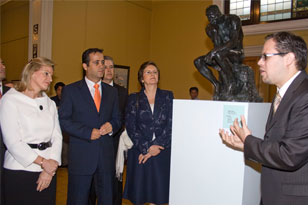

Museo de Arte Italiano
Lima, Perú
October 07, 2008to January 25, 2009
Telmex, Claro and Museo Soumaya, from Fundación Carlos Slim, for first time ever presents thirty sculptures in Lima Peru in the exhibit Del mito al Sueño. Rodin…. Dali (From Myth to Dream. Rodin…Dali) conform to his commitment to the integral developing of the society of Latin America.
Presenting sculptures of six different artists: Auguste Rodin (1840-1917), Pierre-Auguste Renoir (1841-1919), Edgar Degas (1834-1917), Émile-Antoine Bourdelle (1861-1929), Giorgio de Chirico (1888-1978), and Salvador Dalí (1904-1989) from the mythical to the fantastic inspiration, from modernity to the vanguards.
From XIX to XX century, Auguste Rodin introduced a way of representing the human being. Usually with a profound expression, fragmented bodies, and printing original movements, as the modern dance. The authors of this exhibit are Degas with his horses and dancers; Renoir and his Little Venus, robust and curved; Bourdelle and his glamorized Bacchante, Chirico and his admiration for horses and Dali with his soft and impossible watches or his man with a body made up with drawers. All of them introducing innovations following the rules of the French artist.
The visit goes through myths and dreams enclosing five topics: Love, Woman, whose beauty is the inspiration for the French artist and disturbing presence for the Spaniard; the Body, which expresses emotions and discovers the psyche; The Horse which is related to the encounter of man with animal power, and Time, with the amazing droopy watches; for the surrealistic artist, symbol of a reality which represents the unconscious mind.
The display of thirty bronzes goes from de modern lecture of myths to the vanguard. People from Peru will admire fundamental themes for man, as well as icons of the universal art in the Museo de Arte Italiano in Lima, such as Rodin’s Thinker, the watches or Dali’s Cabinet Anthromorphique.
Display of 30 works, the most important:
- The Thinker, Rodin, universal symbol of a free man and creator;
- The Soft Watches, Dali;
- Dalinian Dancer.
The visit
INTRODUCTION: The Modern Man
Between the nineteenth and XX centuries, Rodin and Dali represented two ways of representing the man in the arts. The French artist makes its proposal by expressing emotions and with his creative work, the Spanish artist brought a new element, the unconscious mind as an essential part of human life.
- LOVE
Rodin created many groups for The Gates of Hell, his most important sculpture. He astonished the audience and critics with this new sculpture as he represented myths, accurate truth and sensuality. His couples are often represented in ecstasy, one of his principal characteristics.
In an allegory of love in Surrealism, Dali represents Saint George being animated by his princess. The couple who is besides the soft watch – reality sparked by unconscious – they couldn’t get together: the young man is ashamed of his desires.
Rodin’s Ovid, The phantom kissing the lady; Dali’s Saint George and the Dragon and Parsimony of Time
- WOMAN
Over the years woman has expressed the ideal concept of beauty in arts. Talking about Rodin, Psyche, Eros’ lover, shows the natural pose that always fascinated the artist. Renoir, contemporary to the French artist, proposed tough bodies with rounded shapes. Dali, steeped in the revolutionized XX Century, dissociates the classical essence of beauty; Levite, she’s beautiful and fearful because of the insects sweeping along her body.
- THE BODY
The body shows by dancing one of the most important ways of moving. Renoir’s work reverberates the echo of early music, the expression of Renoir’s bodies performing contemporaneous dances. Degas’ little dancers show the intention of modern art: there are not portraits and addresses a profession frowned at that time.
Dali used dual images, the way to show unconscious mind, as a tribute to dance, turning the hair of his twin bodies into branches. Also in Dalian Dancer, an offering to “Fleming” dance, the dancer is a florid tree.
- THE HORSE
Horses are associated with manhood. Bourdelle dedicated his Work of a Horse without saddle to the gallant figure of Argentina’s Independence General, Carlos Maria Alvear. Edgar Degas, without taking a noble figure into account, contributes with a trendy way of representing horses by means of agility and movement. Giorgio de Chirico presents a rider with a Phrygian cap, symbol of balance between reason and nature. Dali represented his repressed wishes with unicorns facing a wall and a woman turning her back; a horse is also represented in the fearless spirit of the Surrealist Warrior.
- TIME
Movement and naked bodies, bodies are testimony of the passing time in Rodin’s works, as well as in his contemporary fellows. The course of life is seen in a substantial way. Later, Dali and other surrealist authors offered amazing ways to represent time. As Dali said, “the droopy watches expresses a complete reality”, in which the rational or hard way merges with the psycho or soft way. The mechanism of this watch is a crown of time, also melted. The hands points out twilight time with large and frightening shadows. All of these are gorgeous symbols inherited from Dali and the XX Century.
About the Authors Auguste Rodin, father of modern sculpture. He left behind the old Academy, fragmented the body and gave movement to the body by using modern dance. Edgar Degas and his little dancers and horses, testimony of the modern approach in sculpture. Pierre-Auguste Renoir, Rodin’s contemporary, he brings up classical themes but using volume and simple lines. Later on, during the XX Century, artists takes up the style. Emile-Antoine Bourdelle, Rodin’s pupil and the most important sculptor in France after Rodin’s death. He brought his mark to sculpture of the XX Century. Bacchante shows his great admiration for classic art. Giorgio de Chirico, author of the so called metaphysic style. One of his favorite themes was represent riders or gentleman with a Phrygian cap riding a horse symbolizing balance between reason and vital energy of nature. Salvador Dali, shows the unconscious mind disturbing the reason. As example the Cabinet Anthromorphique with its open drawers of innermost desires but with its face covered. Reality would be incomplete without the unconscious mind: Dali incorporates this thought to his work and offers astonishing sculptures, such as his droopy watches, symbol of the XX century. |
About the exclusivity of the exhibition
- The Museo Soumaya will be present in Lima, Peru
- The Museo de Arte Italiano will house the Museo Soumaya for four months
- People from Peru will enjoy these icons of the universal arts, such as Rodin’s Thinker or Dali’s droopy watches.
- During the exhibit will be displayed Dali’s sculpture stage with sculptures created in the surrealistic period of the artist during 1930s.
- It is significant as the authors are very important, as well as the Latin American efforts to exhibit the works, thanks to Grupo Carso, throughout Fundación Carlos Slim’s Telmex, Claro and Museo Soumaya.
From Myth to Dreams. Rodin….Dali. Museo Soumaya, Mexico City.
Rodin’s collection of the Museo Soumaya, Fundación Carlos Slim, is the second most important collection throughout the world. From its compilation, the Museo Soumaya brings to Lima the best of three hundred European sculptures from nineteenth and XX Centuries created by the most famous artists of Europe, such as Rodin, and his contemporaries, pupils and progressives, such as Carpeaux, Carrier-Belleuse, Daumier, Renoir, Degas, Bourdelle, Camille Claudel, Matisse, Maillol, Picasso, Miro, Ernst, Dali, among many others.
The exhibits of Museo Soumaya have been traveled around Mexico and have been hosted by the most important museums in the United States, Europe, Asia, South America and Central America.
Educational Activities
Guided tours are planned for public in general, as well as special tours for blind and visually impaired people.
Schedules and Adress
Museo de Arte Italiano
Paseo de la República 250 – Cercado de Lima
Telephone: 423-9932
e-mail: ivelaoch@terra.com.pe
Visits: Tuesday-Friday 10 to17: 30 hours | Saturday 10 to17 hours | Sunday 11 to15 hours | Monday closed
Information in Mexico City
Museo Soumaya • Fundación Carlos Slim
Altamirano 47, Col. Tizapán San Ángel,
01090, México, D.F.
(+ 52 + 55) 56 16 37 31 Public Relations ext. 304
www.museosoumaya.org
 |
 |
 |
|
 |
|
| << back |
